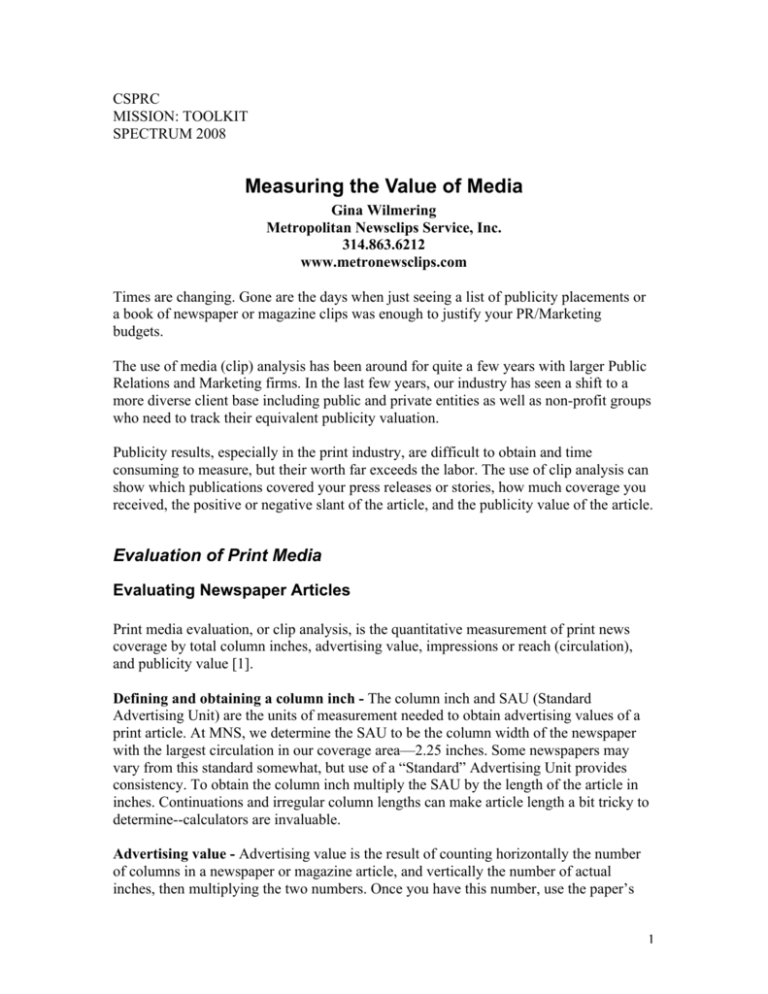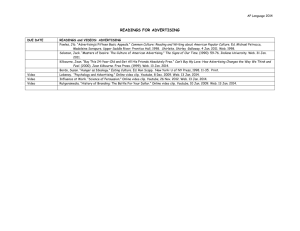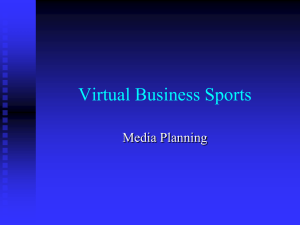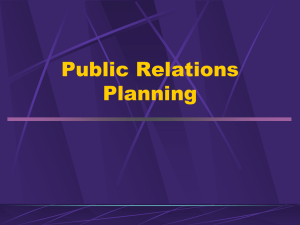Measuring the Value of Media
advertisement

CSPRC MISSION: TOOLKIT SPECTRUM 2008 Measuring the Value of Media Gina Wilmering Metropolitan Newsclips Service, Inc. 314.863.6212 www.metronewsclips.com Times are changing. Gone are the days when just seeing a list of publicity placements or a book of newspaper or magazine clips was enough to justify your PR/Marketing budgets. The use of media (clip) analysis has been around for quite a few years with larger Public Relations and Marketing firms. In the last few years, our industry has seen a shift to a more diverse client base including public and private entities as well as non-profit groups who need to track their equivalent publicity valuation. Publicity results, especially in the print industry, are difficult to obtain and time consuming to measure, but their worth far exceeds the labor. The use of clip analysis can show which publications covered your press releases or stories, how much coverage you received, the positive or negative slant of the article, and the publicity value of the article. Evaluation of Print Media Evaluating Newspaper Articles Print media evaluation, or clip analysis, is the quantitative measurement of print news coverage by total column inches, advertising value, impressions or reach (circulation), and publicity value [1]. Defining and obtaining a column inch - The column inch and SAU (Standard Advertising Unit) are the units of measurement needed to obtain advertising values of a print article. At MNS, we determine the SAU to be the column width of the newspaper with the largest circulation in our coverage area—2.25 inches. Some newspapers may vary from this standard somewhat, but use of a “Standard” Advertising Unit provides consistency. To obtain the column inch multiply the SAU by the length of the article in inches. Continuations and irregular column lengths can make article length a bit tricky to determine--calculators are invaluable. Advertising value - Advertising value is the result of counting horizontally the number of columns in a newspaper or magazine article, and vertically the number of actual inches, then multiplying the two numbers. Once you have this number, use the paper’s 1 open (black and white) advertising rate and multiply the result of columns and actual inches by the open ad rate per column inch for that publication. Publicity value - Publicity value is defined in our industry to be a multiplication of 3 X the advertising value, reflecting a reasonable dollar amount for the effect this article had for use as publicity. Publicity value may reflect either positive or negative publicity as indicated by Slant. Slant - Slant is a subjective evaluation of an article typically using a table of 10 with 5 as neutral and 4-1 slant from trending “negative” to “very negative” and 6-10 trending “positive” to “very positive.” So, an article with a negative slant would mean that the publicity value would be viewed as “X dollars of negative publicity.” Circulation - Circulation represents the number of people that read a newspaper on any given day. Circulation can vary from day to day with Sunday circulation usually higher especially in large daily newspapers. Both advertising rates and circulations change, therefore, at MNS we contact each publication that we read once a year to update our database. The update process usually takes several weeks. Measuring photos - MNS values all newspaper photos as black and white. The photos are given a column inch measurement just as editorial print. We do note in the information provided for that clip if a color photo is included in the article. If one wishes to account for color photos or graphics in an article, measure an article as we have discussed (multiply total column inches by the B/W rate) and add in the one-time color rate onto the rate you obtained for the article for the color photo. For example: an open B/W rate for a publication is $ 50.00 per column inch, and the article is 20 inches, the media value is $1000.00. Now, the cost of advertising in color is $500.00 more for a onetime color price fee, so the media value for that one article would be $1500.00. Ethics - The degree to which a client is the subject of an article can make measuring articles a little tricky. If the client is mentioned throughout the whole article or is the focus throughout the whole article, then credit is given for the whole article. If there is just a single mention of our client, we count one inch for that story. Calendars are counted as one inch, but if very small, then .5 inches are given. (Clients receive the print clip as well; we note on our clip report that there was a mention in a larger article or we note that the mention was a calendar). The point is to communicate to our clients that, for example, they may be looking at a 30 inch clip but they may have just had a minor mention, so the publicity value was calculated using an advertising measurement of one inch. Negative articles are noted in our reports. Some clip analysis programs will take negative articles, record the analysis as a negative dollar amount, and subtract that from the report total. We don’t encourage this because humans do the clip analysis reports. I have looked at some articles which appear positive or neutral to me but someone else may see it as negative. 2 Open ad rates are used for the pricing of print media. Other forms of media use negotiated rates. There is some talk of negotiated rates being used for print as well because it is rare that a print ad is purchased as a one time only placement. But for now, our industry standard is the use of open ad rates. Measuring Magazine Articles The easiest way to measure magazine clips is to convert the magazine clipping to column inches such as used for newspaper articles Finding the column inch - The measurement of magazines is then done the same as measuring newspapers. We use the same SAU rate as for newspapers (2.25 inches). Most open ad rates for magazines are given as full page, _ page, etc. In order to find the per column inch rate, we must divide the full page ad rate by the number of column inches to obtain the per column inch rate, so you first must measure a full page of the magazine. Magazine Column Inches = Page Width / 2.25 X Article Height Advertising Value = Full Page Ad Price / Magazine Column Inches Example: A magazine has a full page size of 8.5 inches wide and 11 inches tall. The cost of a full page ad is $100.00 8.5 / 2.25 X 11 = 40.7column inches then $100 / 40.7 = $2.45 per column inch. Measuring color vs. B/W photos - Magazine ads are purchased with set prices for black and white advertising with ascending prices for 2, 3, and 4-levels of color. For uniformity, we use a black and white measurement. We do note if a photo is present and if the photo is in color or black and white. Some agencies factor in color by taking the total column inches by the open B/W rate and then add the one-time color fee on top of that. Evaluation of Internet Media On-Line Newspapers and Blogs How does one evaluate a form of media that has no set circulation, publicity value or traditional advertising rates? Internet information is not easily verified if the information is in the form of on-line forums or blogs. Internet information provided by newspapers or magazines with online editions use different advertising rates than a traditional print publication does. Most print publications now have internet editions on line and these editions have advertising available. Our industry has no set standard on how to 3 determine the value of editorial coverage. We at MNS are just now beginning to obtain some information for the analysis for this media source. Monitoring online newspapers - At MNS, we use four different search engines to monitor on-line editions of newspapers. We then edit the “hits” for relevance and accuracy before sending the clips or links to our clients. Though we have offered this service for monitoring and providing on-line links and clips to our clients for a while, we are still trying to determine the importance and relevance of clip analysis of these links and clips. Note that internet articles may be abbreviated or different from the print editions of the same article. This can affect everything from publicity value, to slant, especially if the client was mentioned but was not the focus of the whole article. Monitoring blogs and other internet sites - Monitoring blogs and other internet sites such as on-line forums are important to view primarily because although this information may be subjective or potentially inaccurate it is still “out there” for everyone to see. We do monitor these sites as well. This information is edited and forwarded to our clients for them to determine the relevance of this information, but we currently do not calculate publicity value. Methods for doing so vary widely at this time—I will present one method as an example. Obtaining advertising rates for on-line newspapers - To obtain the ad rate for these newspapers, you must contact each website’s advertising department, though some newspaper web sites have this information online. For this presentation I researched 2 online newspaper sources: The Houston Chronicle has several different ad types available on-line such as Banner ads, “1st Click,” and Top Story banners. The Columbia Daily Tribune has Banner ads (located at the top of the web page, SkyScraper ads (located at the right of the web page) and the Cube (located at the bottom of a page below text.) Determining advertising values from internet media searches - To use the example approach [2], you will need to contact the website to find out two things: • the Average Daily visits or, if the website only provides Average Monthly visits, then obtain that number and divide by 30, and • The CPM (Cost per Thousand Impressions) ad rate (most ad rates are sold by CPM). The formula to use is as follows: Daily Average Visits / 1000 X Ad Rate. Then use the conversion of 50 editorial words = banner cost (this method equates the value of 50 words of text to be equivalent to the value of an advertising banner on the page). So for example, to calculate an advertising value using the Columbia Daily Tribune banner advertising rate of 728x90 pixels at $14.00/thousand, 4 30,000 Average Daily Visits / 1000 X $14.00 Banner Ad Rate = $420.00 With a 300 word article then, $420 X 6 = $2,520. So, the advertising value is $2,250 dollars. An example alternative approach is to evaluate the importance and placement of the story and applying valuation to that story according to the dollar amount of the corresponding ad types. For instance a “1st Click” story (one which you see upon your “first click” to enter the web site) would have a corresponding advertising value of the “1st Click” ad rate. For example a story on the Houston Chronicle web site is a top “1st Click” story and the corresponding advertising rate for a 1st Click ad rate is $2,000 per day for a one time only ad. So the advertising value of the 1st click story is $2,000. Determining circulation and publicity values - Web site circulation fluctuates daily, as it is based on the concept of “hits,” or daily visits. The traditional print publicity value multiplier of 3 has no relation to this circulation model, so the calculation of publicity value is still a wide-open area of discussion within our industry. Assessing the slant of blogs and spurious internet sources - Finally, as stated above, blogs and some internet sources are prone to be subjective, potentially inaccurate, and often unaccountable. So while it is important to provide this information, only the client can ultimately determine the relevance. Clearly, the valuation of Internet information is an immature discipline. Conclusion Clip analysis is an indispensable tool that merits a place in your PR toolbox. When integrated with an intelligent strategy of on line monitoring and TV/radio analysis it can occupy a vital role in your PR game plan to evaluate the value provided your clients and to justify your work in an era of shrinking budgets and increasingly competitive market conditions. References 1. “PRtrak Installation and User’s Guide,” TRAKWare Incorporated, 1998. 2. “Measuring Media Coverage Effectively,” VMS White Paper, www.vidmon.com/pdf/Measuring_Effectively.pdf 5









